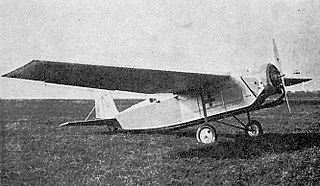
The Bloch MB.160 was a fourteen-seat French airliner intended for use in the French African colonies. Three were built and two entered service with Régie Air-Afrique at the start of World War II. Developments included the Bloch MB.162 bomber which was too late for service and the Sud-Est SE.161 Languedoc, one hundred of which were built post-war.
The Bloch MB.90 was the first all-metal French light aircraft. Only two aircraft were completed, making their first flights in 1932, though there were several variants.

The Potez 31 was a prototype French two-seat night fighter, flown in about 1928, intended to fill the Cn.2 specification for the Armee de l'Air. Only one was built.

The Aviméta 88 was an all-metal French two-seat reconnaissance-fighter or heavy fighter tested in 1927.

The SAB DB-80 and SAB DB-81 were single-engine, all-metal French light transports aimed at the air mail market whilst carrying two passengers. Identical apart from their engines, they flew in mid-1930.

The Lorraine-Hanriot LH.70 or S.A.B. LH.70 was a French trimotor designed to a 1930 government programme for a colonial policing aircraft. Only two were built.
The Romano R.5 was a French reconnaissance flying boat built in 1932. It had a parasol wing, a single engine and hull stabilizing sponsons. Only one was built.

The Dewoitine D.430 was a three-engine, high-wing monoplane designed for policing and other roles in France's colonies. It did not go into production.

The Nieuport-Delage NiD 590 was a three engine, high wing monoplane designed for policing and other roles in France's colonies, which did not go into production or enter service.

The four-engined Lioré et Olivier LeO H-27 was one of three French flying boats competing to carry mail over Air France's South Atlantic routes. Flying later than its competitors, it was not selected and only one was built.
The Weymann W-100, Weymann CTW-100 or Weymann W-100 RBL was a French three seat observation aircraft with a position for the observer within its partially glazed fuselage. Only one was built.

The CAMS 110 was a French twin engine biplane flying boat built to fill a range of maritime military roles including long range reconnaissance, bombing and general exploration. It was not selected for production and only one was built.

The Wibault 260 R.2 was a contender for a French government contract for a long range, two seat reconnaissance aircraft, issued in 1928. There were eight prototypes in the 1931-2 contest and the Wibault was not selected for production.

The Guillemin JG.40 was designed and built to meet a French government requirement for a small air ambulance capable of operating in the colonies. Two were completed and performed well but the JG.40 did not reach production.

The Lioré et Olivier LeO H-23 was a French military flying boat, primarily intended for coastal reconnaissance, though able to carry a small bomb load. Only one was built.
The unsuccessful French Farman F.200 of 1923 shared its type name with the 1929 Farman F.200, the progenitor of a series of parasol wing tourers. It was a two-seat touring aircraft, with a low, thick, cantilever wing. Only one was built and only briefly tested.

The CAMS 54 was a strengthened and more powerful version of the French CAMS 51 civil transport and naval reconnaissance flying boat, developed for transatlantic flights. It is sometimes referred to as the 54 GR.

The Lumière-de Monge racer was built specifically to compete in the 1921 Coupe Deutsch de la Meurthe and was flown at Etampes on 1 October 1921. In addition to its speed, it was unusual in being a high wing monoplane which could be rapidly converted into a biplane by adding a smaller lower wing. It crashed before the race, killing its pilot, and was unable to participate.

The Blériot-Spad S.45 was a large, four engine French airliner which appeared at the 1921 Paris Salon. It could carry fifteen passengers or be adapted as a bomber.
The Caspar CJ 14 was a German fighter aircraft prototype built in the 1920s.















